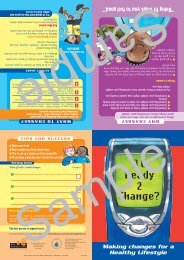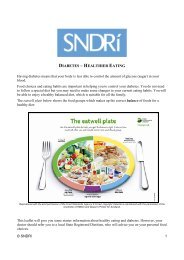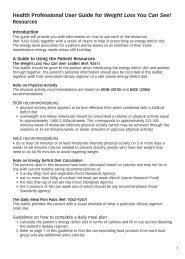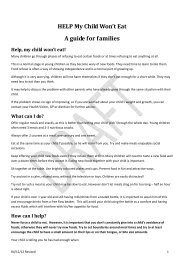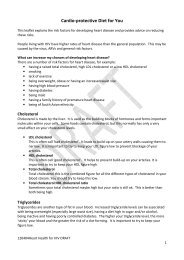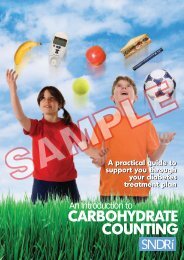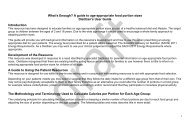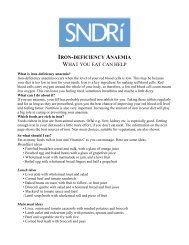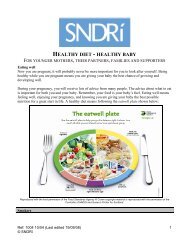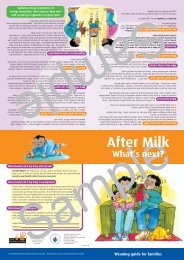Food for the School Years AG - NDR-UK
Food for the School Years AG - NDR-UK
Food for the School Years AG - NDR-UK
Create successful ePaper yourself
Turn your PDF publications into a flip-book with our unique Google optimized e-Paper software.
Vitamin D – <strong>the</strong> sunshine vitamin<br />
Vitamin D is made in your skin when you are outside in daylight during summer.<br />
Very few foods contain this vitamin so spend time outside every day – take care<br />
not to get sunburnt.<br />
Salt<br />
Eating too much can cause high blood pressure. You can reduce your intake by<br />
not adding it to food and by cutting down on salty foods such as crisps, salted<br />
nuts and processed foods especially tinned and packet soups and ready meals.<br />
<strong>Food</strong> <strong>for</strong> <strong>the</strong><br />
<strong>School</strong> <strong>Years</strong><br />
Advice <strong>for</strong> 5-16 year olds<br />
Vegetarians<br />
As vegetarians do not eat meat and fish, it is milk, eggs, cheese, dahl, beans, hummus<br />
and nuts that provide essential protein. A vegetarian diet will be nutritious if a wide<br />
variety of foods are eaten AND plenty of high iron foods are included.<br />
For more in<strong>for</strong>mation, refer to <strong>the</strong> leaflet called ‘Following a Vegetarian Diet’, also<br />
produced by <strong>the</strong> BDA Paediatric Group.<br />
Vitamin, mineral and o<strong>the</strong>r supplements<br />
If you eat a wide variety of foods from all 5 food groups you will not need a<br />
supplement. If you take one, choose one with a wide range of nutrients. Check you are<br />
not getting very high doses of certain vitamins or minerals, especially vitamin A.<br />
Exercise<br />
Some exercise every day is important. Seek out something you enjoy and limit <strong>the</strong><br />
time you spend in front of a computer, TV or DVD.<br />
Worried about your weight getting too high?<br />
Cut down on foods high in fat and sugar and be more active. Eat more fruit and<br />
vegetables andchange to skimmed milk and low-fat yoghurts. Continue to eat from all<br />
<strong>the</strong> food groups so that you keep growing and stay healthy. For more help contact your<br />
GP.<br />
The BDA Paediatric Group is a<br />
Specialist Group of<br />
The British Dietetic<br />
Association<br />
The British Dietetic Association<br />
5th Floor, Charles House,<br />
148/9 Great Charles Street,<br />
Queensway, Birmingham B3 3HT.<br />
Fax: 0121 200 8081<br />
e-mail: info@bda.uk.com<br />
www.bda.uk.com<br />
This in<strong>for</strong>mation has been produced <strong>for</strong> S<strong>NDR</strong>í by Registered Dietitians and o<strong>the</strong>r relevant health<br />
professionals. At <strong>the</strong> time of publication <strong>the</strong> in<strong>for</strong>mation contained within <strong>the</strong> leaflet was, to <strong>the</strong> best<br />
of our knowledge, correct and up-to-date. Always consult a suitably qualified dietitian and/or your<br />
GP on health problems. S<strong>NDR</strong>í cannot be held responsible <strong>for</strong> how clients/patients interpret and use<br />
<strong>the</strong> in<strong>for</strong>mation within this resource.<br />
To re-order visit www.gcu.ac.uk/sndri<br />
and follow instructions<br />
Ref: FFSY 04/08 (05/10)<br />
Hosted by Glasgow Caledonian University and funded by <strong>the</strong> Scottish Government. A Registered Dietitians’ project, in partnership with o<strong>the</strong>r agencies.<br />
A guide <strong>for</strong> families<br />
To stay fit and healthy you need to<br />
choose a variety of <strong>the</strong> right types<br />
of foods to provide all <strong>the</strong> essential<br />
nutrients.<br />
Eating regular meals ra<strong>the</strong>r than<br />
grazing on snacks throughout <strong>the</strong><br />
day, usually gives a better balance of<br />
foods and nutrients.<br />
Eating a wide variety of<br />
foods provides more<br />
nutrients so have a<br />
main course and a<br />
pudding at lunch<br />
and <strong>for</strong> your<br />
evening meal.<br />
Eat toge<strong>the</strong>r as a family and make<br />
meals fun, social occasions.<br />
Convenience foods, chosen carefully,<br />
can be part of a healthy meal. Select<br />
those with lower amounts of salt, fat<br />
and sugar and serve <strong>the</strong>m with extra<br />
vegetables and fruit.<br />
Breakfast<br />
Leave enough time <strong>for</strong> breakfast<br />
because concentrating on school work<br />
is more difficult if you haven’t eaten.<br />
Good choices include:<br />
High-fibre cereals e.g. Weetabix,<br />
muesli, Cheerios, Shreddies and<br />
Shredded Wheat - with<br />
fruit and milk. Try fresh,<br />
canned or dried fruit.<br />
Boiled egg with<br />
wholemeal toast spread thinly with<br />
butter or margarine. Plus a glass of<br />
fruit juice or a piece of fruit.<br />
Porridge with milk and a glass of<br />
fruit juice.<br />
Toast with butter and jam or<br />
marmalade and a glass of milk or hot<br />
chocolate to drink. Instead of toast, try<br />
chapatti, crumpets, English muffins or<br />
pancakes.<br />
If you are running late, have a<br />
sandwich and carton of milk or fruit<br />
juice on <strong>the</strong> way to school.<br />
<strong>School</strong> meals<br />
Try to make up your meal with<br />
something from each of <strong>the</strong> 5 food<br />
groups.<br />
Have some meat, fish, eggs, beans,<br />
dahl or lentils every day. Try to have<br />
red meat at least 2-3 times per week<br />
and fish 1-2 times per week. Burgers,<br />
sausages, pastry foods, battered or<br />
crumbed meat and fish products are<br />
usually very high in fat. You should try<br />
to limit <strong>the</strong>se foods to once per<br />
<strong>for</strong>tnight.<br />
Add at least one starchy food e.g.<br />
pasta, rice, jacket or boiled potatoes,<br />
bread or chapatti. Starchy foods<br />
which have been cooked in oil - such<br />
as potato chips, wedges and roasted<br />
potatoes - are high in fat and should<br />
be limited to once or twice per week.<br />
Fill <strong>the</strong> rest of your plate with<br />
vegetables. These may be cooked,<br />
raw or in salad. Always try to have at<br />
least one type of vegetable with your<br />
school meal each day.<br />
Complete your meal with a drink (e.g.<br />
milk or pure fruit juice) and a pudding.<br />
Choose fruit, yoghurt or a dessert which<br />
contains fruit e.g. fruit crumble.<br />
Packed lunches<br />
Include something from each of <strong>the</strong><br />
5 food groups <strong>for</strong> a nutritious lunch.<br />
Choose different types of bread <strong>for</strong><br />
more variety: sliced bread, bread<br />
rolls, pitta bread, chapatti, naan,<br />
bagels, baps, baguette, crispbread,<br />
crackers and tortilla wraps.<br />
Wholemeal, granary and wheatgerm<br />
varieties have more fibre.<br />
Popular sandwich fillings are ham<br />
and tomato, tuna and cucumber,<br />
cheese and pickle, egg mayonnaise<br />
and cress, chicken and salad, hummus<br />
and peppers. Low-fat mayonnaise and<br />
spreads keep <strong>the</strong> fat content down.<br />
Alternatives to sandwiches are pizza<br />
slices, pasta or rice salad, samosas,<br />
slices of quiche or bread sticks with<br />
cheese and vegetable sticks.<br />
Include vegetables in sandwiches or<br />
as a salad or add some cherry<br />
tomatoes, carrot or celery sticks.<br />
Include a piece of fruit (fresh, dried<br />
or tinned) and a pudding such as<br />
yoghurt or a small piece of cake that<br />
contains fruit.<br />
Always have a drink.<br />
Snacks<br />
Most children and teenagers need 1<br />
or 2 snacks as well as 3 meals each<br />
day.<br />
The best choices are sandwiches,<br />
yoghurt, breakfast cereals and fruit<br />
because <strong>the</strong>y will give you energy and<br />
nutrients.<br />
Crisps, savoury snack biscuits,<br />
chocolates, sweets, cakes, cereal<br />
bars and processed fruit bars<br />
contain a lot of fat, sugar and salt<br />
but very few vitamins or minerals.<br />
Instead of <strong>the</strong>se, choose nuts, seeds,<br />
plain popcorn or vegetable snacks which<br />
have no added fat, sugar or salt.<br />
Drinks<br />
To keep yourself well hydrated, try<br />
to have 6-8 drinks each day. You<br />
may need more in hot wea<strong>the</strong>r.<br />
Plain water and plain, semiskimmed<br />
or skimmed milk are <strong>the</strong><br />
best choices.<br />
Yoghurt drinks, smoothies and juice<br />
are also good choices. Pure fruit juice<br />
is better than ‘Fruit Juice Drink’’<br />
because it has more nutrients.<br />
Fizzy drinks, squashes, fruit juice<br />
drinks, sports drinks and some<br />
flavoured waters give you energy<br />
but very few nutrients. Some of<br />
<strong>the</strong>se drinks also contain acids<br />
which may damage teeth. Limit<br />
<strong>the</strong>m to once a day.<br />
If you do have<br />
<strong>the</strong>se drinks, having<br />
<strong>the</strong>m with your<br />
meals will do less<br />
damage to your<br />
teeth. More damage<br />
can happen if <strong>the</strong>y are drunk on <strong>the</strong>ir<br />
own.<br />
Iron<br />
You need iron-containing foods<br />
regularly. Teenage girls need <strong>the</strong><br />
most.<br />
The best sources are red meat and<br />
o<strong>the</strong>r meats including pork and<br />
chicken. Some iron is also found in<br />
pulses, beans, nuts, egg yolks and<br />
oily fish - sardines, mackerel and<br />
salmon. There is also a small<br />
amount in dark green leafy<br />
vegetables. Some breakfast cereals<br />
have added iron.<br />
Iron is better absorbed from meals<br />
which include foods high in vitamin C<br />
e.g. fruits and vegetables. Oranges,<br />
tomatoes and fruit juices are<br />
particularly high.<br />
Avoid drinking tea with meals as it<br />
reduces <strong>the</strong> amount of iron absorbed<br />
from food.
<strong>Food</strong> Groups<br />
Eating a combination of foods from all <strong>the</strong> food groups will give you all <strong>the</strong> nutrients you need to stay healthy and keep growing.<br />
Putting most foods into <strong>the</strong> food groups is easy. But some foods are made up of ingredients from more than one food group. For example pizza - <strong>the</strong> base is<br />
from <strong>the</strong> bread, rice, potatoes and pasta group; tomatoes and tomato sauce are from <strong>the</strong> fruit and vegetables group; <strong>the</strong> cheese is from <strong>the</strong> milk and dairy group;<br />
and it may have meat or fish from <strong>the</strong> protein group.<br />
As well as energy, <strong>the</strong> nutrients you need each day are protein, vitamins, minerals (such as calcium, iron and zinc), fibre and omega 3 and omega 6 fats.<br />
Fruit and vegetables<br />
Bread, rice, potatoes and pasta<br />
Always have fruit and vegetables<br />
at every meal and aim <strong>for</strong> at least 5<br />
servings a day. Fruit and vegetables<br />
give you vitamins A and C and<br />
fibre. Some contain a little iron.<br />
Tips:<br />
Have a wide range.<br />
Avoid over-cooking vegetables as<br />
this destroys some of <strong>the</strong> nutrients.<br />
Cook <strong>the</strong>m in a small amount of<br />
water and <strong>for</strong> a short time so <strong>the</strong>y<br />
are still ‘crisp’ when served.<br />
Don’t soak vegetables in water as<br />
some of <strong>the</strong> nutrients, like vitamin C,<br />
will be left behind in <strong>the</strong> water.<br />
Frozen fruit and vegetables are<br />
usually just as nutritious as fresh.<br />
Choose tinned vegetables without<br />
added salt.<br />
Stir fried or roasted vegetables,<br />
using very little oil, are usually<br />
more popular than boiled<br />
vegetables.<br />
Have sliced salad<br />
vegetables with<br />
sandwiches, picnics<br />
and packed<br />
lunches.<br />
Sticks of raw vegetables with a<br />
sauce to dip into makes a great<br />
snack.<br />
Always choose a pudding with<br />
fruit or eat fruit with your pudding<br />
e.g. strawberries go well with cake.<br />
Ano<strong>the</strong>r way of having vegetables is<br />
to add <strong>the</strong>m to pizzas, burgers,<br />
soups, stews and casseroles.<br />
Dried fruit is good with breakfast<br />
cereals and in puddings and cakes.<br />
It can damage your teeth, like<br />
sweets do, if you eat it on its own<br />
as a snack.<br />
Have at least one food from this<br />
group with each meal.<br />
They include: breakfast cereals,<br />
bread, chapatti, pasta, rice,<br />
couscous, millet, potatoes,<br />
cornmeal, yam and green banana.<br />
<strong>Food</strong>s made with flour e.g. pizza<br />
bases, buns and pancakes are also<br />
in this group.<br />
These foods give you plenty of<br />
starch (carbohydrates) <strong>for</strong> energy.<br />
They also give you B vitamins,<br />
fibre and some iron and zinc.<br />
Tips:<br />
Choose breakfast cereals with<br />
added vitamins and iron e.g.<br />
cornflakes and Rice Krispies.<br />
Wholegrain varieties e.g. Weetabix,<br />
Shreddies and Cheerios have more<br />
fibre as well.<br />
Oat cereals e.g. muesli and porridge<br />
are high in iron and also fibre and<br />
give you energy right through <strong>the</strong><br />
morning.<br />
Have wholemeal, granary and rye<br />
breads as well as white as <strong>the</strong>y are<br />
higher in fibre. You can also try<br />
pitta bread, chapattis, English<br />
muffins, bagels, crumpets and bread<br />
sticks.<br />
Have pasta shapes with meat,<br />
tomato or cheese sauce.<br />
Try <strong>the</strong> nutty taste of brown<br />
rice in savoury dishes as a<br />
change from white rice.<br />
Have potatoes baked,<br />
mashed or try a jacket<br />
with a filling. Eating <strong>the</strong><br />
potato skins gives you<br />
more fibre.<br />
Meat, fish,<br />
eggs, beans and<br />
o<strong>the</strong>r non-dairy<br />
sources of protein<br />
Have foods from this group twice a day.<br />
These foods give you protein, iron, zinc,<br />
magnesium, B vitamins and vitamin A. Some give<br />
you omega 3 fats.<br />
Tips:<br />
Lean meat with <strong>the</strong> visible fat cut off be<strong>for</strong>e cooking<br />
will be lower in calories than fatty meat but will still have<br />
all <strong>the</strong> nutrients.<br />
Use lean minced beef, turkey, chicken, pork or lamb to<br />
make burgers, meatballs, meatloaf, bolognese sauce or<br />
shepherd’s pie.<br />
Chicken and turkey skin has a lot of fat, so leave it out or<br />
don’t eat it.<br />
Put tuna, cold meat, pastes, pâtés, mashed sardines,<br />
hummus or peanut butter in sandwiches or on toast.<br />
Pulse vegetables such as lentils, chick peas, red<br />
kidney and baked beans make good curries and<br />
casseroles.<br />
Fish is quick and easy to cook. If you have fish in batter,<br />
it is only <strong>the</strong> batter which is very high in fat, not <strong>the</strong> fish.<br />
Oily fish (salmon, fresh tuna, mackerel, pilchards,<br />
sardines) contain omega 3 fats which are good <strong>for</strong> your<br />
brain and heart. As <strong>the</strong>se fish may contain small<br />
amounts of pollutants, boys can have up to 4 portions<br />
each week but girls should keep to 1 or 2 portions a<br />
week. Avoid shark, swordfish and marlin as <strong>the</strong>y may<br />
contain high levels of mercury.<br />
Sausages, chicken nuggets, burgers and fish fingers are<br />
popular but choose those lower in fat and salt or make<br />
<strong>the</strong>m yourself. Grill or bake <strong>the</strong>m ra<strong>the</strong>r than frying.<br />
Eggs can be boiled, poached or scrambled. Omelettes<br />
and eggy bread are different ways to serve eggs.<br />
<strong>Food</strong>s and drinks high in<br />
fat and/or sugar<br />
These foods should be eaten in small amounts.<br />
They are high in calories but have very few<br />
nutrients. Eating too many of <strong>the</strong>se foods may<br />
make you overweight or obese. This can cause<br />
diabetes and heart disease.<br />
<strong>Food</strong>s in this group include cream, butter,<br />
margarines, cooking and salad oils, mayonnaise,<br />
chocolate, crisps, sweets, biscuits, cakes, ice<br />
cream, pastries, fizzy drinks, sweets, jam, syrup<br />
and sugar. When using fats and oils choose<br />
some with high levels of omega 3 fat such as<br />
walnut oil, rapeseed oil and olive oil.<br />
Tips:<br />
Spread butter and margarine very thinly.<br />
Frying foods in fat or oil adds extra calories.<br />
Grilling, baking or steaming foods doesn’t.<br />
If you have ice cream, biscuits or a piece of cake<br />
make <strong>the</strong>m small portions and add some fruit to<br />
make a more nutritious pudding or snack.<br />
Have sweets and chocolate at <strong>the</strong> end of a meal<br />
ra<strong>the</strong>r than in between meals so that <strong>the</strong>y do not<br />
damage your teeth.<br />
Try your drinks without adding sugar as <strong>the</strong> sugar<br />
just adds extra calories and no nutrients.<br />
Milk, cheese<br />
and yoghurt<br />
Have three servings of milk, yoghurt or cheese<br />
each day.<br />
These foods give you protein, calcium, B vitamins<br />
and iodine.<br />
Tips:<br />
Milk is a very nutritious drink. Choose semiskimmed<br />
or skimmed milk. These have less fat and<br />
fewer calories than full-fat milk, but have <strong>the</strong> same<br />
amounts of protein, calcium and most o<strong>the</strong>r<br />
nutrients.<br />
Flavoured milk and yoghurt drinks are also healthy<br />
options, but make sure to check how much sugar<br />
has been added. Try to choose brands that have<br />
less than 10g of ‘total sugars’ per 100ml.<br />
Have milk on breakfast cereals as a snack.<br />
Have yoghurt or fromage frais as a pudding or<br />
snack between meals. Use <strong>the</strong>m in place of cream.<br />
Try to select brands which are lower in fat and<br />
contain no added sugar.<br />
Try paneer in curries or have yoghurt with curry.<br />
Grated cheese, cheese spreads or cheese portions<br />
can be used as sandwich fillers, on toast or as a<br />
snack.<br />
Add cheese to jacket potatoes, pasta, savoury<br />
flans, or use it in white sauce to make macaroni<br />
cheese and cauliflower cheese.




